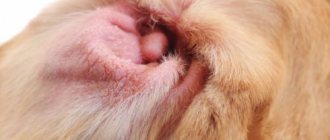For a dog owner encountering seizures in a dog for the first time, this sight comes as a real shock. However, you must try to pull yourself together, calm down and help your pet, who at the moment really needs it.
Let's look at the reasons why seizures occur in dogs and how you can help your pet.
Types of seizures
Seizures in dogs are divided into four types.
- Convulsions are small, jerky muscle spasms. The animal is able to remain on its feet, does not lose consciousness, and responds to commands. Externally, convulsions look like twitching and may not immediately attract the owner’s attention.
- Tonic convulsions - veterinarians consider their manifestation not too serious a threat, since these are short-term muscle contractions. However, the pet is in pain. During tonic spasms, the dog is conscious and what is happening frightens it. She may whine and become confused in a familiar, homely environment. It is easy to identify this species externally thanks to slow twitching at the same time interval.
- Clonic convulsions - a distinctive feature is a long period of time. This is a seizure in which dogs experience repeated bouts of convulsions once every 30 seconds to two minutes. The spasm goes away and the dog tries to get up, but soon a new wave of the attack makes him fall again. The animal is in pain. It is difficult to react to an unexpected condition.
- Epileptic seizure - from the name it is clear that this type of illness is dangerous and severe. It is characterized by: complete loss of consciousness, tension and constant muscle contraction. The animal's eyes are often closed, but an attack is possible with open eyes without signs of reaction. The dog is in pain. After a seizure, he does not recover immediately. The gait will be unsteady and swaying. The state is sluggish.
Problems, as well as tips that can help in treating the disease
Unfortunately, it is impossible to quickly cure a dog of a disease such as epilepsy; treatment will last quite a long time. Medical treatment for this disease is recommended for all animals that have seizures more than once a month. If the animal had a group attack, then it needs to be treated even if the attacks did not recur. Successful treatment of this disease will depend on how careful the owner is, as well as the type of treatment. It is prohibited to change the dose or type of treatment without consulting a specialist. Self-efficacy in treatment will be even worse than inaction. Such actions may worsen the situation. If you suddenly change the type of medication, or stop taking them, the seizures will return again. Also, if your doctor tells you to stop taking a certain drug, remember that many drugs have physical dependence. In order to prevent the situation from worsening, the dosage should be reduced gradually.
Most veterinary clinics located in Russia do not have the ability to provide the necessary tests to detect epilepsy in a dog. That is why we can only hope how professional the veterinarian will be. However, the information presented in this article will help you understand the essence of this disease. Unfortunately, not all veterinarians are competent enough, and if you doubt the competence of a doctor, try to find another specialist. It is best to contact clinics that have many positive reviews.
The problem is that not all medicines are freely available. Certain anticonvulsants are sold in pharmacies with prescriptions, which must be prescribed by a neurologist. These products are not available with prescriptions from a veterinary clinic. This is why you need to consult your doctor about which medications are more affordable.
We also recommend that you consult with your doctor about the recommended diet for your dog, as well as what vitamins it needs. If you take some vitamins, they will have a good effect on your dog's health.
The main thing in a situation with epilepsy is not to be scared. If a dog has this disease, but it is treated correctly, then it will not be different from other, healthy dogs. If your dog takes medication, he will be able to get rid of seizures. Often, seizures during treatment begin only at the moment when the medicine is stopped or the drug is changed. If you follow the advice of experts, your dog will feel good.
Causes
Seizures in dogs have reasonable causes. This is a visible manifestation of the disease. Only a qualified veterinarian can establish a connection between muscle spasms and disease, but every owner should be aware of diseases with such manifestations.
- Eclampsia. The disease occurs due to a lack of calcium in the body. Animals of small breeds weighing up to 5 kg are most often affected. Pregnant and lactating bitches are especially susceptible. The result of a long-term lack of calcium in the blood is convulsions.
- Hypoglycemia and hyperglycemia - there is not enough glucose in the blood or there is an excess. Both are deviations from the norm that cause metabolic disorders. Kidneys and liver suffer. When neglected, it leads to serious damage to internal organs and the brain. The disease can be hereditary and acquired as a result of an improper diet.
- Intoxication of the body caused by any reason - poisoning, bites of poisonous animals, insects, advanced disease - is also the cause of seizures. One of them is hyperammonemia - dysfunction of the kidneys. The body poisons itself with untimely elimination of the breakdown products of substances.
- Injuries to the spine, head, internal organs.
- Infectious diseases are a common cause of uncontrolled convulsions. Dangerous to humans - rabies.
Epilepsy, as a cause of prolonged, painful seizures, deserves separate consideration. It occurs due to disturbances in the functioning of the brain due to a tumor, injury, inflammation, previous or untreated infectious disease, or heredity.
Epilepsy is in most cases a genetic disorder. Therefore, pets suffering from this disease are not recommended to reproduce. Next, there are acquired causes that affect the brain:
- Intoxication.
- Plague, toxoplasmosis, tetanus.
- Snake and insect bites.
- Helminths.
- Skull injuries.
- Malnutrition.
- Kidney diseases, cirrhosis.
- Diabetes.
- Hypovitaminosis.
- Mineral deficiency.
- Arrhythmia, brain cancer.
- Electric shock.
Often, due to inexperience, seizures are confused with a drunken gait of an animal, the cause of which is degenerative myelopathy. Rhythmic twitching during sleep is normal for puppies. And old dogs can tremble in their sleep and even whine. However, this is also a normal phenomenon and is completely different from painful cramps.
Who is at risk?
Seizures are most often observed in small breed dogs. This is explained by their tendency to low blood glucose levels, and, accordingly, to hypoglycemic attacks. Also, miniature individuals more often suffer from eclampsia - a sharp increase in blood pressure.
Males are more susceptible to seizures: males are much more prone to epilepsy and neurological disorders than females.
This disease is common in collies, dachshunds, poodles, Labradors, huskies, and boxers. These breeds are at increased risk of congenital or acquired epilepsy.
What to do
- You should not be afraid, scream, shake the animal and scare it even more with your reaction.
- At home, you need to move your pet to a familiar place, where there is no bright lighting, sharp corners and there is fresh air. If this happens during a walk, you need to cross the shade in the hot season, and in the cold season find bedding on the bare ground: collect leaves, tear off the cardboard, put your pet in the trunk of the car.
- Turn your pet on its right side, this makes breathing easier.
- There is no need to give your dog any medications, try to give him water to drink, or massage his muscles while the spasm continues.
- If a seizure occurs for the first time for unknown reasons, you should immediately consult a doctor. If unexpected spasms are an unpleasant reality that you have to live with and struggle with, then you should record the frequency and, when visiting a veterinarian, talk about the course of the disease.
- Given modern technology, it is good to ask someone or yourself to film the attack on your phone. Then it will be easier for the doctor to determine the symptoms of the disease.
Convulsions and foaming at the mouth in a dog
Convulsive spasms most often accompany diseases such as eclampsia, epilepsy, diabetes mellitus (hypoglycemia), and tumors. Convulsions and foam can also occur due to poisoning, severe infestation, allergies to drugs and side effects of medications.
The secretion of saliva and foam can be triggered by physical overload, heat stroke, or eating toxic garbage or sharp objects (stomach trauma).
It is necessary to carefully monitor your pets during walks, and also use medications only as directed or coordinate treatment with a specialist.
First aid
It is difficult for an ignorant person to expect an attack or predict its approach, but it is possible to be prepared for such a situation. The duration of the seizure or its course cannot be influenced. The goal is to prevent more severe consequences.
- Record how long the spasms and other noticeable manifestations last. Observe which muscles cramp the most: the front legs, the hind legs or the whole body.
- Try to prevent the dog from hitting objects, a wall, a tree, or falling down the stairs.
- Place your pet on the bedding.
- At the end of the seizure, gently stroke and offer water. You should not feed yet.
- Support your dog emotionally with care. She is confused and does not understand why this is happening.
- If a pain attack does not end for more than 10 minutes or after completion the pet does not come to its senses for more than thirty minutes, you need to call an ambulance or go to the doctor yourself.
Life-threatening convulsive syndrome - epistatus. The attack lasts 5-7 minutes and is repeated at intervals of less than 30 minutes. Requires immediate assistance.
It is forbidden:
- stick out your tongue, try to open or close your mouth;
- leaving your pet alone;
- It is advisable that during and after a seizure the animal is not frightened by loud sounds or irritated by strong and pungent odors.
Prescription drugs
Your veterinarian may prescribe one or more antiseizure medications to control your dog's seizures:
- Phenobarbital
- Potassium bromide (KBr)
- Primidon
- Imepitoin
- Zonisamide
- Keppra (levetiracetam)
For many dogs, antiseizure therapy goes through a period of trial and error. Medications can be combined, adjusted, or changed until your dog's seizures stop.
In many cases, laboratory tests must be performed regularly to monitor your dog's response to medications and overall health.
Never change your dog's medications without specific instructions from your veterinarian. Communication with your veterinarian is vital, and it is important that you adhere to their recommendations if you want treatment to be successful. With care and attention, your dog can live a long, healthy life despite occasional seizures.
Treatment
Only a doctor should prescribe medications and treatment. For a high-quality diagnosis, it is necessary to take blood and urine tests. Additional research will be required:
- Ultrasound; MRI; CT; ECHO;
- X-ray of the spine, skull;
- examination by a veterinarian-neurologist.
The priority and need for research is determined by the doctor.
Immediately, even before detailed tests, the veterinarian may prescribe intramuscular injections of magnesium sulfate. Thanks to the antihistamine effect of the drug, attacks will not recur in the near future. Then, more detailed treatment will follow. It is dangerous to administer the drug yourself.
The main reason why an animal cannot be cured is neglecting the veterinarian’s recommendations and stopping treatment on its own. It's a big mistake to rely on your own judgment. It may seem that everything is fine with your pet, there have been no seizures for a long time and it is enough to stuff him with medications. However, only a specialist can say with confidence that the disease has receded, after confirming a visual examination with additional studies. A methodical approach to treatment depends on the owner, and professional recommendations depend on the doctor.
Diagnosis of the disease
To diagnose the causes of seizures in your pet, you will need to conduct a number of tests and instrumental studies:
- Clinical and biochemical blood test.
- General urine analysis.
- Stool analysis for parasites.
- Ultrasonography.
- X-ray.
- MRI.
Once you have all the necessary information, you will need to contact a veterinarian who specializes in neurological diseases, since seizures are most often a sign of neurological diseases.
When should you rush to the vet?
Can you notice the signs of an approaching attack? Yes. To do this, it is important to know what physiological parts a seizure consists of.
- The first phase is Aura. Over a short period of time or several days, the dog behaves restlessly: periodically trembles, increased salivation. Howls for no reason, hides or wanders aimlessly around the territory. These same signs are characteristic of other painful conditions. So it’s difficult to say one hundred percent that a seizure is approaching. However, if the owner knows about the possibility of an attack, then such factors will help decide on further actions.
- The second phase is Impact. Convulsions begin lasting several seconds or minutes. The dog falls and dodges. Saliva flows from the mouth. He might wet himself.
- The third phase is the post-traumatic period. Occurs immediately after impact. The pet is confused and disoriented. It may not respond to the owner or, conversely, cuddle and ask for protection. This period lasts up to several days.
You should rush to see a doctor:
- if the attack occurs more than twice during the day;
- if the duration of one seizure is more than 10 minutes;
- if the next seizure begins when the animal has not yet returned to normal after the previous one;
- if even before the attack there were alarming conditions: refusal of water, food, lethargy, vomiting, diarrhea, difficulty breathing;
- if the dog is chronically ill;
- if a puppy has a seizure.
Course of a seizure
Typically, a seizure can be divided into several stages:
- The first stage, preceding the attack itself, is called an aura. At this time, the dog may drool excessively, become restless and begin to wander aimlessly. This condition can be observed in a dog from several minutes to several days, depending on the condition of the body.
- The most difficult stage is the blow, that is, the attack itself, accompanied by convulsions, the dog’s hind legs fail, and in some cases there is a strong flow of saliva and involuntary urination. This stage lasts for several minutes.
- After the attack, a post-traumatic stage begins, during which the animal becomes lost and disoriented. During this period, the dog may avoid the owner or, conversely, show excessive affection towards him, and profuse salivation may also continue. The duration of the post-traumatic stage varies, and it can end in minutes, or it can drag on for a day or two.
A single attack does not pose a particular danger to dogs, but frequently repeated seizures lasting for 10-15 minutes are a serious threat to the life and health of the animal.
Prevention
Veterinarians recommend preventive measures that do not guarantee, but reduce the likelihood of disease.
- Balanced diet; This measure looks like a general recommendation, but its importance does not diminish. Nutrient imbalances are always dangerous. In this case, you should pay attention to the amount of glucose and calcium in the pet’s body.
- Avoiding contact with household chemicals, as well as toxic substances that can easily be found on the street.
- Walking on a leash is recommended if the area is unfamiliar and not fenced; It is important to remember that if the dog becomes confused after an attack, it may run away.
- Regular scheduled vaccinations.
How to detect and cure true epilepsy?
After a dog has its very first seizure, regardless of its age, it is necessary to consider absolutely all causes except primary epilepsy. Many diseases and disorders can cause attacks. That is why it is necessary to fully examine the dog’s body in order to make an accurate diagnosis. If the cause of such attacks is not found, a diagnosis of true epilepsy can be made.
Often, if a dog's seizures are very short and infrequent, he will not need anticonvulsant therapy. But if the seizures are longer or more frequent, you need to consult a specialist. There are certain medications that treat epilepsy; they work to balance the functioning of the brain. The following medications can be used to treat epilepsy in dogs:
- Phenytoin. This drug has no sedative effect, it is very effective, and there are no side effects. However, this drug is difficult to give to a dog, it is quickly eliminated from the blood, the dog is constantly thirsty, and urination increases.
- Phenobarbital. This is a very effective drug that has a fast speed of action, it can be taken in a variety of ways, this remedy is one of the most effective for this disease. However, this drug has a sedative effect that lasts a long time, it increases the dog’s thirst, increases its irritability, and the dog becomes restless.
- Primidon. This is a very effective drug that works quickly. However, it has a strong sedative effect, it greatly increases the dog’s thirst and appetite; this remedy is only available in tablet form.
- Diazepam. Thanks to this drug, you can control the exacerbation of attacks, as well as control the condition of the epilepticus. This remedy is very effective in stopping this condition, it acts quickly, and is also completely safe for the dog. However, the effect is short-lived, it cannot cope with a severe attack of epilepsy, it causes restlessness in the dog, as well as severe irritability.
Often, if phenobarbital is combined with potassium bromide or sodium bromide, then this combination will better help a dog that is not helped by the separate use of drugs.
Which breeds are more susceptible to muscle spasms?
As noted above, in this article, small breeds are at risk : dwarf Spitz, Yorkshire terriers, Chihuahuas. The reasons are different. Premature birth and poor feeding guarantee an imbalance of glucose and calcium. Stressful situations and changes in the usual environment also affect the metabolism of these children. Miniature individuals have a weaker nervous system.
Of the large breeds, labradors, huskies, and collies are most often affected. From medium poodles and dachshunds. Here, more often than not, heredity plays a significant role.
Experienced breeders know that epilepsy can manifest itself in the early stages of development of babies, so it is possible to select puppies with manifestations of the disease. The first sign of which is convulsions.
What diseases can seizures be symptoms of?
There are a huge number of pathologies that can cause the development of involuntary muscle contractions.
Let's look at the most common of them:
- Diseases of the cardiovascular system are accompanied by a lack of oxygen, which leads to disruption of the nervous system and the development of convulsive syndrome;
- Infections . A striking example is rabies, tetanus or common canine plague. The pathological process can be either viral or bacterial in nature, and pathogens cause serious damage to nervous tissue. Rabies cannot be cured, so the only way to combat it is timely vaccination;
- Postpartum exlampsia . The disease is directly related to calcium metabolism disorders and is recorded in recently given birth bitches. An insufficient amount of calcium leads to a change in the intensity of transmission of nerve impulses;
You might be interested in our article: Childbirth in a dog: what and how to do? What to prepare for?
- Diabetes . Seizures occur in response to improper nutrition of brain cells. The consequence may be loss of consciousness, paralysis, coma or death of the pet. The cause of seizures is both the incorrectly calculated dosage of the drug and the lack of timely intake of glucose into the body;
You will find more information in the article: Diabetes mellitus in dogs: causes, treatment, prevention
- Poisoning or intoxication. Scientists clearly differentiate poisoning of a dog’s body by poisons or toxins, heavy metals and other chemicals from classic food poisoning. In the first case, the pet experiences convulsions, and the second occurs against the background of a disorder in the gastrointestinal tract;
- Anaphylactic shock;
- Epilepsy.
You will find more information in the article: Epilepsy in dogs: all about the disease and first aid rules
It is important to understand that it is unlikely that you will be able to figure out the cause of seizures on your own. At the first symptoms, you should immediately seek the advice of a specialist.
conclusions
Cramps are not a disease, but only a symptom. Leaving this sign unattended is extremely dangerous. Hoping that this happened once and will not happen again is unreasonable. Starting self-treatment is fraught with aggravation of the disease. It is important to get more information about the possible causes of cramping and decide what to do next.
In addition to medical care, the little friend needs emotional rehabilitation. Lack of control over one's own body, pain, and loss of consciousness lead the already weak animal into a state of shock. Maximum care should be taken. Talk calmly, kindly. Praise and hug gently. And the main thing is to be nearby.
The owner must understand that seizures are a manifestation of the disease and not hope that this was a one-time incident. The dog needs help both urgently and permanently. If the attacks are ignored, the animal will suffer and die as a result. At some point, coexistence with people will become impossible due to the manifestation of an advanced disease. Then it will be too late to contact the veterinarian. Treatment requires timeliness.
Read more: How to stop epileptic seizures in dogs
Classification of epilepsy by type of seizure
- Generalized epileptic seizures. The condition that is commonly thought of when one hears of epilepsy. These are attacks in which the epileptic focus spreads to both hemispheres of the brain, respectively, the attacks are generalized, that is, they are observed on both sides of the body. Usually occurs with loss of consciousness. Convulsions that occur during generalized epileptic seizures are usually:
A. Tonic - short-term rigid muscle tension and extension of the limbs.
b. Clonic - uncoordinated, sudden, aimless movements of the limbs.
V. Tonic-clonic - a sequence of tonic and clonic phases, replacing each other.
d. Myoclonic - rhythmic movements of a body part (usually on both sides of the body) as a result of sudden involuntary muscle contraction, followed by relaxation.
There are also non-convulsive generalized epileptic seizures, which are called atonic; they represent a sharp loss of muscle tone, and the animal falls.
- Focal epileptic seizures. Seizures in which the epileptic focus is located in one hemisphere and the symptoms are local in nature. These can be motor, behavioral, autonomic disorders and manifest themselves both individually and together.
A. Motor disturbances: periodic focal motor phenomena (rhythmic jerking of the head or excessive blinking, repeated twitching of one limb, contractions of the facial muscles).
b. Autonomic disturbances: vomiting, dilated pupils, drooling, uncontrolled bowel movements or urination.
V. Behavioral disorders: episodic changes in the animal's behavior. A usually peaceful animal can become aggressive, or vice versa, animals can suddenly begin to hide or seek the proximity of the owner.
- Focal epileptic seizures turning into generalized ones. The case when seizures begin as focal ones, which are associated with the local spread of pathological epileptic activity of neurons in the brain, which subsequently spreads to both hemispheres. The clinical picture looks accordingly: first, behavioral, autonomic or motor disturbances, which are quickly replaced by generalized seizures.
Signs of disease: how to understand that your pet needs help?
It is quite difficult to recognize myositis in a dog at the initial stage. The first thing that should alert the owner is stiffness and difficulty in movement. At the first stage, this condition is observed in the morning or after a long sleep. The pet moves very carefully and carefully. The “doll” gait persists throughout the day.
Other signs indicating the development of traumatic, purulent (infectious) or other forms of myositis:
- Soreness . When palpating the affected area, the dog experiences severe pain. This is expressed by aggression (the pet growls, grins) or loud squealing. Pain also occurs with sudden movements, so the dog behaves carefully: does not run, does not jump on heights, etc.
- Increased body temperature . The main feature is that the temperature is elevated over a long period of time, and in particular, this applies to the affected area of the body. When palpating, you will notice that the skin at the site of inflammation is dry and hot.
- Decreased appetite. This symptom occurs in all forms of the disease, but it is most pronounced in eosinophilic myositis. Due to inflammation of the chewing muscles, the dog practically cannot open its mouth, so it is very painful for it to eat and even drink water.
- Muscular dystrophy. Cellular metabolism disorders and soft tissue degeneration. Like loss of appetite, this symptom is most pronounced with eosinophilic myositis. The jaw muscles become much smaller in size (almost dry out), and noticeable depressions form in the zygomatic area.
- Additional signs. Your pet may experience anorexia, loss of muscle mass, dehydration, protruding eyeballs, and swelling in various parts of the body. Possible atrophy of the masticatory muscles, purulent lesions, etc.
Have you noticed signs in your pet that indicate the development of myositis? Don't hesitate - contact a veterinary clinic! Only an experienced veterinarian will be able to correctly diagnose and prescribe effective treatment to prevent the onset of dangerous consequences of the disease.











